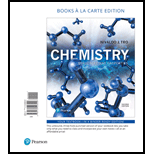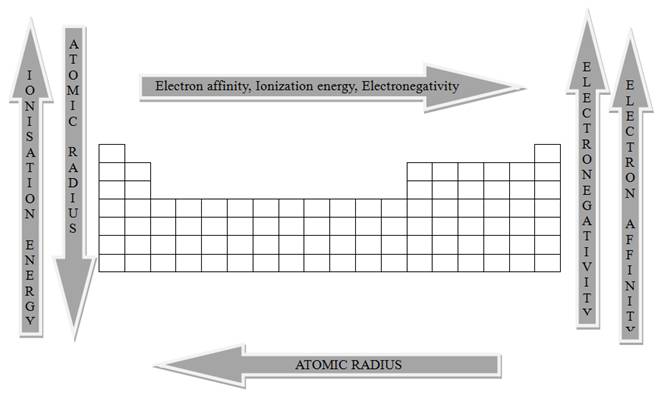Problem 1E: What are periodic properties? Problem 2E: Use aluminum as an example to explain how density is a periodic property. Problem 3E: Explain the contributions of Dobereiner and Newlands to the organization of elements according to... Problem 4E: Who is credited with arranging the periodic table? How are elements arranged in this table? Problem 5E Problem 6E Problem 7E: What is an electron configuration? Provide an example Problem 8E Problem 9E Problem 10E: What is penetration? How does the penetration of an orbital into the region occupied by core... Problem 11E: Why are the sublevels within a principal level split into different energies for multi-electron... Problem 12E Problem 13E Problem 14E: What are degenerate orbitals? According to Hund’s rule, how are degenerate orbitals occupied? Problem 15E: List all orbitals from 1s through 5s according to increasing energy for multi-electron atoms. Problem 16E Problem 17E: Copy this blank periodic table onto a sheet of paper and label each of the blocks within the table:... Problem 18E: Explain why the s block in the periodic table has only two columns while the p block has six. Problem 19E: Explain why the rows in the periodic table become progressively longer as we move down the table.... Problem 20E: Explain the relationship between a main-group element’s lettered group number (the number of the... Problem 21E: Explain the relationship between an element's row number in the periodic table and the highest... Problem 22E: Which of the transition elements in the first transition series have anomalous electron... Problem 23E: Explain how to write the electron configuration for an element based on its position in the periodic... Problem 24E: Explain the relationship between the properties of an element and the number of valence electrons... Problem 25E Problem 26E Problem 27E: What is effective nuclear charge? What is shielding? Problem 28E: When an alkali metal forms an ion, what is the charge of the ion? What is the charge of an alkaline... Problem 29E: When a halogen forms an ion, what is the charge of the ion? When the nonmetals in the oxygen family... Problem 30E: Use the concepts of effective nuclear charge, shielding, and n value of the valence orbital to... Problem 31E: For transition elements, describe the trends in atomic radius as we: move across a period in the... Problem 32E Problem 33E: Explain how to write an electron configuration for a transition metal cation. Is the order of... Problem 34E Problem 35E Problem 36E Problem 37E: What are the exceptions to the periodic trends in first ionization energy? Why do they occur? Problem 38E Problem 39E Problem 40E: What is metallic character? What are the observed periodic trends in metallic character? Problem 41E Problem 42E Problem 43E: Determine whether each element is a main-group element. tellurium potassium vanadium manganese Problem 44E: Determine whether each element is a transition element. Cr Br Mo Cs Problem 45E: Write the full electron configuration for each element. Si 0 K Ne Problem 46E Problem 47E: Write the full orbital diagram for each element. N F Mg AI Problem 48E Problem 49E: Use the periodic table to write the electron configuration for each element. Represent core... Problem 50E: Use the periodic table to determine the element corresponding to each electron configuration. [Ar]... Problem 51E: Use the periodic table to determine each quantity. the number of 2s electrons in Li the number of 3d... Problem 52E: Use the periodic table to determine each quantity. the number of 3s electrons in Mg the number of 3d... Problem 53E Problem 54E Problem 55E: Determine the number of valence electrons in each element. Ba Cs Ni S Problem 56E Problem 57E: Which outer electron configuration would you expect to correspond to a reactive metal? To a reactive... Problem 58E Problem 59E Problem 60E: List the number of valence electrons in each element and classify each element as an alkali metal,... Problem 61E: Which pair of elements do you expect to be most similar? Why? N and Ni Mo and Sn Na and Mg CI and F... Problem 62E Problem 63E: Predict the charge of the ion formed by each element and write the electron configuration of the... Problem 64E: Predict the charge of the ion formed by each element and write the electron configuration of the... Problem 65E: According to Coulomb’s law, which pair of charged particles has the lowest potential energy? a... Problem 66E Problem 67E Problem 68E: Arrange the atoms according to decreasing effective nuclear charge experienced by their valence... Problem 69E: If core electrons completely shielded valence electrons from nuclear charge (i.e., if each core... Problem 70E: In Section 3.6/, we estimated the effective nuclear charge on beryllium’s valence electrons to be... Problem 71E Problem 72E: Choose the larger atom in each pair. Sn or Si Br or Ga Sn or Bi Se or Sn Problem 73E: Arrange these elements in order of increasing atomic radius: Ca, Rb, S, Si, Ge, F. Problem 74E: Arrange these elements in order of decreasing atomic radius: Cs, Sb, S, Pb, Se. Problem 75E: Write the electron configuration for each ion. O2 Br Sr2+ Co3+ Cu2+ Problem 76E: Write the electron configuration for each ion. Cl P3 K Mo3+ V3+ Problem 77E: Write orbital diagrams for each ion and determine if the ion is diamagnetic or paramagnetic. V5+... Problem 78E: Write orbital diagrams for each ion and determine if the ion is diamagnetic or paramagnetic. Cd2+... Problem 79E: Which is the larger species in each pair? LiorLi+ IorCs+ CrorCr3+ OorO2 Problem 80E: Which is the larger species in each pair? SrorSr2+ NorN3 NiorNi2+ S2orCa2+ Problem 81E: Arrange this isoelectronic series in order of decreasing radius: F , O2 , Mg2+ , Na+ . Problem 82E: Arrange this isoelectronic series in order of increasing atomic radius: Se2, Sr2+ , Rb+ , Br . Problem 83E: Choose the element with the higher first ionization energy in each pair. BrorBi Na or Rb As or At... Problem 84E Problem 85E: Arrange these elements in order of increasing first ionization energy: Si, F, In, N. Problem 86E Problem 87E: For each element, predict where the “jump” occurs for successive ionization energies. (For example,... Problem 88E Problem 89E: Choose the element with the more negative (more exothermic) electron affinity in each pair. Na or Rb... Problem 90E Problem 91E: Choose the more metallic element in each pair. SrorSb As or Bi Cl or O S or As Problem 92E Problem 93E Problem 94E Problem 95E Problem 96E Problem 97E: Both vanadium and its 3+ ion are paramagnetic. Use electron configurations to explain this... Problem 98E: Use electron configurations to explain why copper is paramagnetic while its 1+ ion is not. Problem 99E Problem 100E: Suppose you were trying to find a substitute for Na+ for some application. Where would you begin... Problem 101E Problem 102E: Which pair of elements would you expect to have the most similar atomic radii, and why? Si and Ga Si... Problem 103E: Consider these elements: N, Mg, O, F, Al. Write the electron configuration for each element. Arrange... Problem 104E: Consider these elements: P, Ca, Si, S, Ga. Write the electron configuration for each element.... Problem 105E Problem 106E: Explain why vanadium (radius = 134 pm) and copper (radius = 128 pm) have nearly identical atomic... Problem 107E: The lightest noble gases, such as helium and neon, are completely inert—they do not form any... Problem 108E: The lightest halogen is also the most chemically reactive, and reactivity generally decreases as we... Problem 109E Problem 110E Problem 111E Problem 112E: Write the electronic configurations of the six cations that form from sulfur by the loss of one to... Problem 113E: You have cracked a secret code that uses elemental symbols to spell words. The code uses numbers to... Problem 114E: The electron affinity of sodium is lower than that of lithium, while the electron affinity of... Problem 115E: Use Coulomb’s law to calculate the ionization energy in kJ/mol of an atom composed of a proton and... Problem 116E Problem 117E: Consider the densities and atomic radii of the noble gases at 25 °C: Element Atomic Radius (pm)... Problem 118E Problem 119E: Consider the metals in the first transition series. Use periodic trends to predict a trend in... Problem 120E: Imagine a universe in which the value of ms can be +12 , 0, and 12 . Assuming that all the other... Problem 121E: A carbon atom can absorb radiation of various wavelengths with resulting changes in its electronic... Problem 122E: Only trace amounts of the synthetic element darmstadtium, atomic number 110, have been obtained. The... Problem 123E: What is the atomic number of the as yet undiscovered element in which the 8s and 8p electron energy... Problem 124E: The trend in second ionization energy for the elements from lithium to fluorine is not a regular... Problem 125E: Unlike the elements in groups 1A and 2A, those in group 3A do not show a regular decrease in first... Problem 126E: Using the data in Figures 3.19 and 3.20/, calculate E (the change in energy) for the reaction... Problem 127E Problem 128E Problem 129E: The heaviest known alkaline earth metal is radium, atomic number 88. Find the atomic numbers of the... Problem 130E: Predict the electronic configurations of the first two excited states (next higher energy states... Problem 131E Problem 132E: The outermost valence electron in atom A experiences an effective nuclear charge of 2+ and is on... Problem 133E Problem 134E: Give a combination of four quantum numbers that could be assigned to an electron occupying a 5p... Problem 135E Problem 136E Problem 137E Problem 138E Problem 139E Problem 140E Problem 141E Problem 1SAQ: 1. According to Coulomb's law, if the separation between two particles of the same charge is... Problem 2SAQ Problem 3SAQ: Choose the correct electron configuration for Se. 1s22s22p63s23p64s23d104p4 1s22s22p63s23p64s24p4... Problem 4SAQ Problem 5SAQ: Which set of four quantum numbers corresponds to an electron in a 4p orbital? n = 4, I = 3, m1 = 3,... Problem 6SAQ Problem 7SAQ: Which statement is true about electron shielding of nuclear charge? Outermost electrons efficiently... Problem 8SAQ Problem 9SAQ: What is the electron configuration for Fe2+? [Ar]4s23d8 [Ar]4s03d6 [Ar]4s23d4 [Ar]4s23d6 Problem 10SAQ: Which species is diamagnetic? Zn Cr 2+ C Mn Problem 11SAQ Problem 12SAQ Problem 13SAQ Problem 14SAQ Problem 15SAQ Problem 16SAQ format_list_bulleted


 Living By Chemistry: First Edition TextbookChemistryISBN:9781559539418Author:Angelica StacyPublisher:MAC HIGHER
Living By Chemistry: First Edition TextbookChemistryISBN:9781559539418Author:Angelica StacyPublisher:MAC HIGHER Chemistry for Engineering StudentsChemistryISBN:9781337398909Author:Lawrence S. Brown, Tom HolmePublisher:Cengage Learning
Chemistry for Engineering StudentsChemistryISBN:9781337398909Author:Lawrence S. Brown, Tom HolmePublisher:Cengage Learning World of Chemistry, 3rd editionChemistryISBN:9781133109655Author:Steven S. Zumdahl, Susan L. Zumdahl, Donald J. DeCostePublisher:Brooks / Cole / Cengage Learning
World of Chemistry, 3rd editionChemistryISBN:9781133109655Author:Steven S. Zumdahl, Susan L. Zumdahl, Donald J. DeCostePublisher:Brooks / Cole / Cengage Learning Introductory Chemistry: An Active Learning Approa...ChemistryISBN:9781305079250Author:Mark S. Cracolice, Ed PetersPublisher:Cengage Learning
Introductory Chemistry: An Active Learning Approa...ChemistryISBN:9781305079250Author:Mark S. Cracolice, Ed PetersPublisher:Cengage Learning




